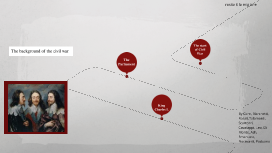Civil War Presentation
Transcript: The Civil War Causes South had farming and agriculture. North had factories and industry Southern way of life was based on a class system: rich, poor, slaves. Northern way of life was based on immigrants finding new opportunities to create business or live life. Could the federal government tell the states what to do about slavery? the numbers People Abraham Lincoln Jefferson Davis General Ulysses Grant General Robert E. Lee Soldiers male 16 years old white black fighting companies came later in the war Daily Schedule Music Wake-Up Call Wash up with soap and tin basin exercises breakfast (potted meats or hardtack) practice with bayonet and battalion drills chores target practice evening parade tent inspection 10pm-bedtime Battles 1861: Battle of Bull Run July 21, 1861 Union had 28,000 troops Confederacy had 33,000 This was the battle Stonewall Jackson refused to surrender 4,900 were killed, wounded, cptured, or went missing PROVED THAT THE WAR WAS NOT GOING TO BE EASILY DECIDED. 1862: Battle of Antietam September 16-18 First invasion into the North by the Confederacy 23,100 men were killed, wounded, or missing in a single day! The battle led to the Emancipation Proclamation by Pres. Lincoln. All slaves were free! 1863: Battle of Gettysburg July 1863 Union Troops: 60,000 Confederate Troops: 50,000 On Day 3 of the battle the Confederate charged the line with 15,000 men but only 5,000 survived...they were mowed down with canons and rifles General Lee lost 28,000 men General Meade lost 23,000 men 1864: Battle of Atlanta May 5-August 31 Sherman & the Union army had 100,000 were closing in on the last big Confederate force Johnston & the Southern army had 65,000 men. They would retreat, fight, and retreat again. This was the final stage of the Ananconda plan. Resources Prisons In the very beginning of the Civil War, prisoners of war were exchanged right on the battlefield, a private for a private, a sergeant for a sergeant and a captain for a captain. In 1862 this system broke down and caused the creation of large holding pens for prisoners in both the North and South. Confederates threatened to treat black prisoners as slaves and to execute their white officers. There was also the problem of prisoners returning too soon to the battlefield. When Vicksburg surrendered on July 4, most of those Confederate prisoners who were paroled were back in the trenches within weeks. Although more than 150 places were used as prisons on both sides during the war, only a handful are important. Generally they fit into certain types: the fortifications, former jails and penitentiaries, altered buildings, enclosures around barracks, enclosures around tents and open stockades. Jacksonville Florida provided some 15,000 troops to the war effort, of which 5,000, or one out of every three, were lost. Florida was an important source of beef and salt (which came from boiled down sea water). The state had mixed reactions to the war effort. There was some considerable union sympathy in the state. Florida was a haven for deserters from the Confederate army. And the Union was able to organize two regiments of cavalry partially from these men. Jacksonville was occupied four different times by Federal troops. January 2-7, 1861. Confederate troops occupy Fort Clinch in Fernandina, and Fort Marion in St. Augustine. February 2, 1862. The Confederates withdraw from Fort Clinch March 5-12, 1862. The Union troops occupy Fort Clinch, St. Augustine and Fort Marion. They also enter Jacksonville. April 9, 1862. Union troops leave Jacksonville. September 11, 1862. Northern boats begin operations in the lower St. Johns River area. October 5, 1862. The Confederates withdraw from Yellow Bluff and St. Johns Bluff. March 10, 1863. The Union reoccupies Jacksonville, but has to leave on March 29, 1863. February 7, 1864. The Union comes back to Jacksonville. February 20, 1864, the Battle of Olustee. Cooney, Patrick L. "Jacksonville Civil War." Discovering Jacksonville and the Surrounding Area: Historical Tours. Web. 07 Apr. 2011. <http://www.vernonjohns.org/nonracists/jxcivwar.html>. Mississippi land Economy Florida Many of the middle states' land was destroyed. Way of Life New York States Rights

















